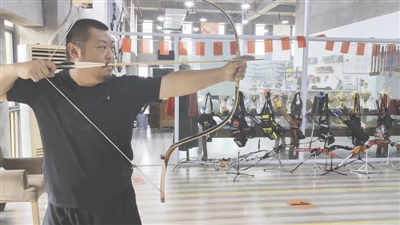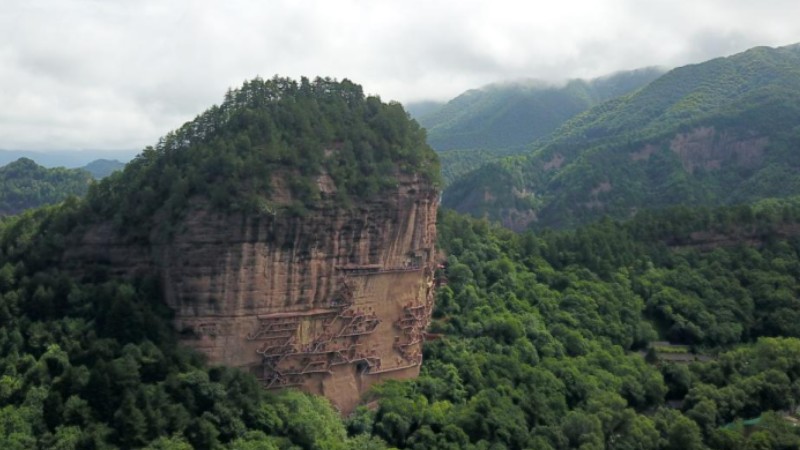Centuries-old bow-making craft in SW China's Chengdu hits the mark with renewed vitality

A photo shows bows and arrows made by Li Qingyang, a Chinese craftsman specializing in restoring old bows and making bows using the traditional techniques of the Wu family. (Photo/Chengdu Economic Daily)
Wu's bow, a symbol of traditional bow-making in southern China, has made a comeback after fading away in the 1970s, according to the Chengdu Economic Daily.
More than a century ago, a craftsman named Wu Zhengfu opened Changxing bow shop in the Qingyang district of Chengdu, the capital of southwest China's Sichuan Province. With the expert bow-making craft passed down through the generations in Wu's family, the shop quickly rose to prominence as one of the most prestigious suppliers of bows in southern China.
However, as firearms grew in popularity in modern times, they gradually replaced bows and arrows on the battlefield. As a result, the Changxing bow shop closed, and Wu's bow faded from public memory.
In 2008, things took a favorable turn when Li Qingyang, a resident of southwest China's Chongqing Municipality, encountered Wu Jiabin, a descendant of Wu Zhengfu and the contemporary inheritor of the Wu family's bow-making craft.
After more than a decade spent restoring traditional bows, Li impressed Wu Jiabin with his sincerity and passion for bow-making techniques. Eventually, Wu Jiabin agreed to teach Li the Wu family's bow-making craft, which had previously been passed down exclusively within the family.
According to Wu Yadi, Wu Jiabin's daughter, the Wu family has been making bows since the Ming Dynasty (1368-1644).
During the Ming and Qing dynasties (1644-1911), the Wu family not only crafted and maintained bows and arrows for generals but also provided training fields and supplies for individuals participating in imperial examinations on military knowledge and skills, Wu Yadi said.
"Our bows are light, handy, powerful and remain durable even with long-term use. Furthermore, they can be folded away when not in use. Among traditional bows, Wu's bow has its unique style," says Wu Yadi. She revealed that it takes three years to craft a qualified bow using the Wu family's bow-making techniques.
"We hope the Changxing bow shop can return to Chengdu, so people will know that bows made by us Chengdu residents have also created a glorious chapter in history," says Wu Yadi.

Li Qingyang, a Chinese craftsman specializing in restoring old bows and making bows using traditional techniques, demonstrates archery with a bow made using the traditional bow-making craft of the Wu family. (Photo/Chengdu Economic Daily)
Now 46 years old, Li has made that wish a reality.
"I always wanted to restore genuine traditional Chinese bows," Li said. He owns a bow-making workshop in Chongqing, which is filled with various tools, devices, and raw materials for making bows.
"The evolution of bows and arrows mirrors the development of human civilization. We want this traditional craft to be known by more people. A well-made traditional bow is no worse than a modern one," he expounded.
Two centuries-old bows, meticulously restored by Li, are displayed on the living room wall of Wu Jiabin, who is in his eighties. One is an ancient bow, once wielded by Yuan Chonghuan, a renowned general of the Ming Dynasty; the other is a royal bow hailing from the Qing Dynasty. Despite their age, both bows function flawlessly.
The high quality of Wu's bow can be attributed to the rigorous craftsmanship involved in its creation.
There are more than 280 steps for making a bow like Wu's, with each step requiring high standards and superb craftsmanship, according to Li.
The choice of materials alone comes with many stipulations. For instance, to create a qualified Wu's bow, an artisan needs to harvest ox horn in the spring, when it is robust; process cattle tendons in summer so that the fat can be removed easily; combine the three essential bow materials in the autumn, a time when hands sweat less; and cut Phyllostachys pubescens, a type of bamboo, in winter, when the bamboo contains less moisture and is thus less likely to decay.
Li dedicates the months of July and August to processing cattle tendons. Given the scarcity of raw materials and the significant loss during processing, each finished cattle tendon is incredibly valuable.
"The cattle tendons must be sourced from farm-raised cattle as their tendons are sufficiently tough due to their extensive physical activity," Li explained.
According to Li, 1.5 kilograms of fresh cattle tendons devoid of fat can only be refined into 100 to 150 grams of qualified tendons.
Li's workshop currently houses more than 10 antique bows awaiting restoration. Several newly crafted Wu's bows are ready for dispatch to eager buyers.
"Our bows are predominantly sold to regions like Europe, America and Mongolia, where there is a tradition of using bows and relevant competitions and activities," Li shared.
Photos
Related Stories
- Experience the fusion of tradition and modernity in Chengdu with Rongbao
- Giving China's treasures a modern touch
- Culture Fact: Explore the cultural city of Chengdu
- Chengdu Universiade kicks off with spirit of inclusiveness
- Chengdu Universiade | Foreign tennis players embrace spirited atmosphere in Chengdu
Copyright © 2023 People's Daily Online. All Rights Reserved.









